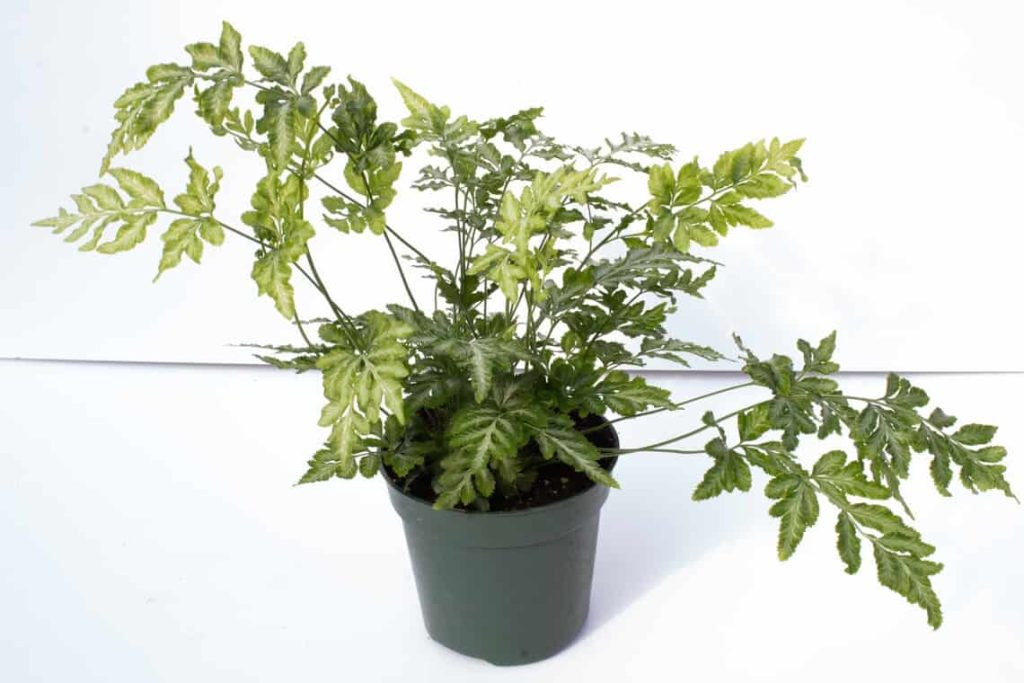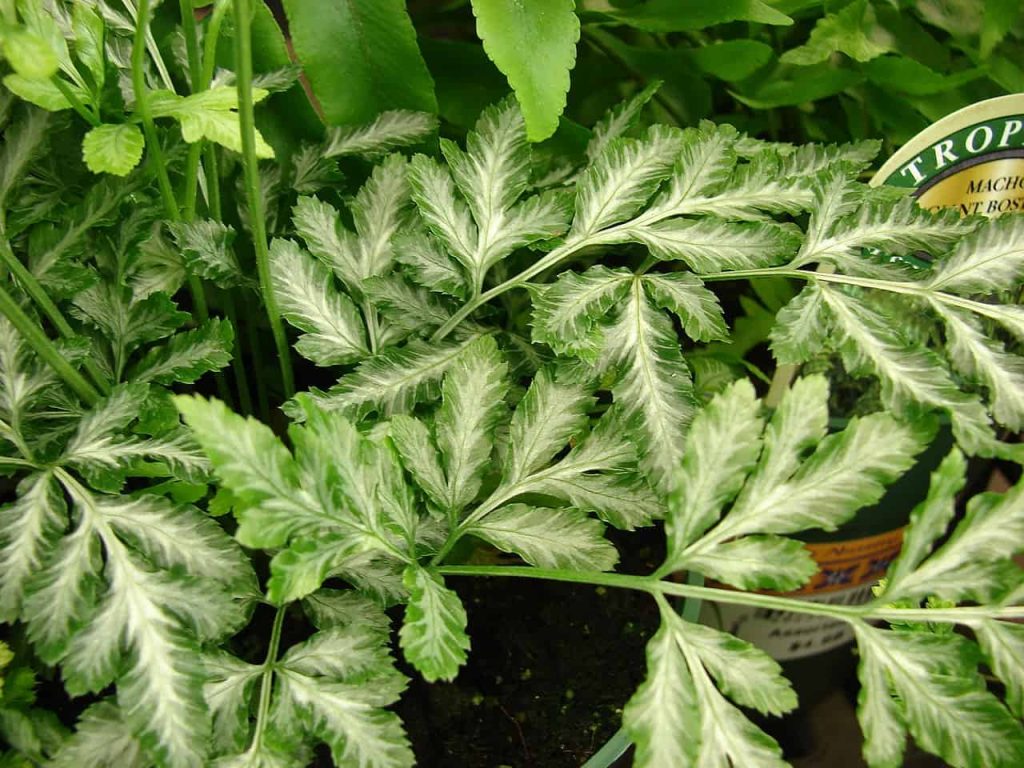There is no end to our love for ornamental plants, and we know this saying is true for a lot of gardeners and plant lovers. We all love the elegance and beauty they add to our space.
While some ornamental plants are light-loving, it is surprising to know that there are ornamental plants that enjoy being placed in indirect to low light, both in your home or workplace. One of our favorite low-light loving ornamental plants is the silver fern and who doesn’t love the elegance and vivid colors that the silver fern adds to the garden or home.
The silver fern is characterized by its green leaves and silvery-like white vein.
Although a lot of people are aware that the silver lace fern is a fast-growing plant and want it grown in their spaces, not many are familiar with its special need and care routine. We thought to make things easy for you, all you need to know, grow, and propagate your silver is right here. Dig in!
Silver Lace Fern Plant Explained
| Botanical name | Pteris Ensiformis “Evergeniensis |
| Common name | Silver lace fern |
| Plant type | Perennial |
| Soil type | Moist, well-drained soil |
| Soil Ph | 5.6 to 7 |
| Temperature | 60 to 70 degrees F |
| Watering | Moderately watered |
| Humidity | High |
| Native | Asia, China |
| Toxicity | Toxic. |
Also known by its scientific name, Pteris Ensiformis “Evergeniensis”, the silver fern is known to belong to the species of brake fern, these species are known to grow a cluster, of flat, oval-shaped leaves. The plant’s name is derived from the silvery color that is at the center of the fronds.
The combination of the green and silver colors makes the plant a spectacular one to view. The plant is native to southeast Asia and China and other tropical regions in the world. The silver lace fern grows well in moist soil under the shade.
Silver Lace Fern Plant Propagation
Propagation is an aspect of gardening that most plant lovers find interesting and look forward to doing.
This is because propagation, not only helps you birth younger and more plants, it is also one way to save your dying plants. The ideal method for propagating the silver fern is via division. Below is a step-by-step instruction on how to go about it.
- Identify and gently remove the selected plant from its pot. Separate the plant’s root from the soil, this can be tricky and you might lose some roots in the soil, however, if you are careful, you will save a lot.
- Divide the plants into sections, however, ensure each section is connected to some roots, has at least one stem and a frond. The parent plant can be divided into more than two, this is solely dependent on how big the plant is.
- Select pots, with drainage holes and fill them with high-quality potting mix, place each division in the pots. The divisions only have to go halfway deep to grow properly, ensure it is well placed in the soil.
- Water each plant properly, remembering that the silver fern enjoys being placed in a moist environment. Gently place the pot of plant in a place where it can receive indirect light. in 4 weeks, your plant’s roots would have been established and this will be evident by new shoots that will sprout from the plant.

Silver Lace Fern Care Guide
Here’s the silver lace fern plant care must-know you’ll find handy.
1. Light
Unlike some other ornamental plants, the silver lace fern will not tolerate being placed in a place that is too bright. However, the plant will survive well when exposed to indirect light or filtered light. This has made the plant very suitable for low-light spots indoors.
2. Water
The silver lace fern thrives best in moist soil this means that there is a provision for watering. The plant will not grow properly if placed in wet or soggy soil. The plant should be watered moderately and be allowed to drain properly before watering again, we discovered that the silver fern has a root structure that requires that water goes through slowly.
We suggest that you check the top 2inches of the soil, to determine when to water your plant again. For ease, we suggest that you create a watering schedule to help you properly meet the need of your plant, when due. Silver fern does not like to be under-watered or left dry, it can hinder the plant’s growth.
3. Humidity
As a tropical plant that the silver fern is, it requires a high humidity level to grow to its maximum capacity, this most times isn’t naturally achievable in the home. However, there are locations in the home whose humidity level is high, such as the bathroom and the kitchen.
There are also proven ways to increase the humidity level for your plant. i.e., misting, placing your plant on a peddle tray. We also recommend purchasing a plant humidifier for your plant.
4. Soil
The silver lace fern will grow properly in medium moist, well-drained soil. We recommend that the plant be placed in a soil pH of about 5.6 to 7. It is to be noted that the silver lace fern will not tolerate both dry or overwatering, as both will impede the growth of the plant.
In making sure that your plant does not stay in soggy soil, we recommend that you purchase a quality potting mix that is rich in peat or potting soil made specially to grow fern. You can also make this mix yourself at home, all you need is peat moss or sphagnum, soil, an equal mix of gravel, charcoal, and sand, all of these should be of the same quantity.
5. Temperature
Being a tropical plant, the silver lace fern will tolerate living in a temperature range of 60 degrees F to 75 degrees F. Similar to many other plants, the silver fern will not tolerate being placed close to vents or drafts.
6. Fertilizer
Fertilizer should be administered on the plant once a month, especially during the growing season, and should be reduced when out of growing season, to once in 8 weeks.
Young plants, below 8 weeks should not be fertilized. We recommend that the fertilizer should be diluted, first, before feeding the plant. This is because undiluted fertilizer can cause burns to your plant. You can also water your plant, right after the fertilizer has been administered, this will reduce the chances of burns on your plant.
Silver Lace Fern FAQs
What Does A Silver Lace Fern Represent?
The silver lace fern is the symbol of the New Zealand national identity; it was accepted as the official symbol in the year 1880s. The silver fern represents strength, resistance, and enduring power. To a tribe in New Zealand, the plant represents new life and new beginnings, however, to the Japanese, it represents family and hope for the future generation.
Is Silver Lace Fern Poisonous?
A part of the silver fern is poisonous, while some parts aren’t. The non-toxic part of the plant is used to treat various ailments and diseases. The poisonous part of the silver fern is the woody trunks. Although the trunks are poisonous, they are known to be useful building materials.
How Long Does It Take A Silver Lace Fern To Grow?
Germination of the seed can take between 2 weeks and many months to occur, however, after this, we believe that the extent of growth is highly dependent on the care that the plant is receiving. Improper care of your plant can hinder its growth and cause its growth to be slow. However, proper provision of the plant’s needs will help it grow as fast as it can.
How Big Can The Silver Lace Fern Get?
The silver lace fern can grow to a height of 10 meters or more. The fronds can however grow to about 4 meters. However, it is to be noted that the fern occasionally takes the creeping form.
How Many Years Can The Silver Lace Fern Live For?
The silver lace fern is a perennial plant, which means that with the right care, the plant can live for more than two years.
Final Thoughts
The silver fern’s care routine may indeed be slightly different from the regular plant, however, we believe this lovely plant is worth every of your attention. Some problems can hit the plant and that you need to look out for. The following tips talk about how to identify and handle these problems.
- Drooping and wilting of leaves is a sign that your plant is being under-watered, you might want to pay attention to your watering schedule and provide water for your plant. Drooping and yellowing of the leaves is a sign that your plant is sitting in soggy soil, you should take the plant out of the soil, cut out the affected parts and place the plant in a new pot of soil.
- Dry and crispy leaves are an indication that your plant isn’t receiving enough humidity. We urge you to place your plant in some high humidity locations in the home or your mist, place it in a peddle tray, or purchase a plant humidifier.
- The silver fern is very sensitive, hence will not tolerate an undiluted fertilizer or over-fertilization. Over-fertilization can produce crinkled, brown, or worse, dead tips. If you notice your plant is suffering from over-fertilization, we recommend that you discard the soil and grow your plant in a new pot of soil.
- The silver fern can be attacked by some pests i.e., mealy bugs, mites. We recommend that you rinse these pests off the plant or spray the leaves with a mix of water and isopropyl alcohol.
Discover more houseplant care guides:
- Rose Of Jericho Plant Care (How to Grow This Plant)
- Stromanthe Triostar Care And Propagation Made Easy
- Sterling Silver Scindapsus Plant Varieties, Propagation, And Care
- Calathea Orbifolia Care And Propagation Made Easy
Featured image: Forest and Kim Starr / Wikimedia Commons / Flickr.

